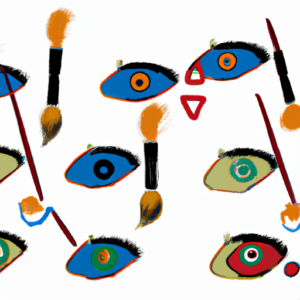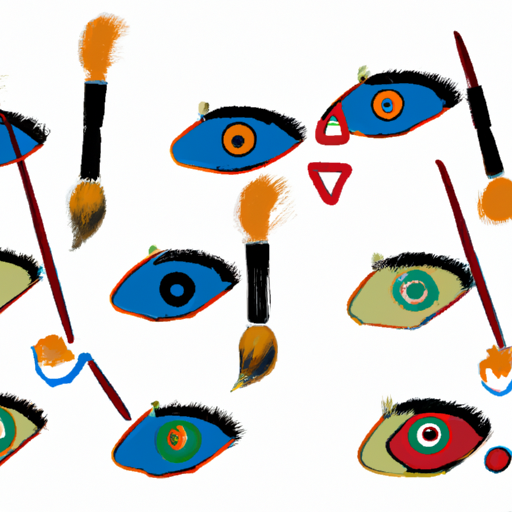Get an Eye-Opening Look at Eye Shapes in Art Throughout History
Hi there! I’m excited to dive into the fascinating world of eye shapes in art with you. First, let’s start with a quick overview of what eye shapes are. In art, eye shapes refer to the different ways in which artists depict the human eye. From small and almond-shaped to large and round, there are countless variations that have been used to convey emotion, symbolism, and beauty. Eye shapes have been an important part of art throughout history, and I can’t wait to explore examples from Ancient Egypt, Greece, the Renaissance period, and even modern art.
As we examine eye shapes in art from different periods, we’ll also delve into the themes and meanings behind them. You’ll see that eye shapes have been used to evoke everything from power and spirituality to sensuality and sadness. By the end of our journey, you’ll have a greater appreciation for how something as simple as an eye shape can convey so much meaning and emotion in a work of art. So, let’s get started!
Ancient Egypt: Eye Shapes in Art
To kick things off, let’s take a trip down memory lane to Ancient Egypt. They were known for their art style, and you may have already seen one of their most iconic shape – the eye. In Egyptian art, the eye is a common symbol and is often exaggerated in its shape. The eye is drawn with a distinctive almond shape and intricate detailing around it. It wasn’t just a pretty shape, though. The eyes in Ancient Egyptian art held a greater meaning. They were believed to be a symbol of protection. The act of drawing an eye was said to invoke the protective powers of the gods, specifically the goddess Wadjet. This significance made the eye shape a popular motif in architecture, jewelry, and other forms of art. In addition to protection, the shape also represented the concepts of wisdom, knowledge, and enlightenment. There’s a reason why Egyptian pharaohs were depicted with heavily lined eyes – it was to convey their higher understanding of the world. This belief in the power of the eye continued beyond Ancient Egypt and can still be seen in modern-day Egyptian iconography.Ancient Greece
Ah, Greece! The land of philosophers, poets, and artists! When it comes to eye shapes in Greek art, there’s no denying that they had a fascination with almond-shaped eyes. You can see this not just in their sculptures and paintings but in their pottery, too. The almond shape, in particular, was popularized by goddesses, like Athena and Aphrodite, and was seen as a symbol of beauty and wisdom.
Now, what’s interesting about Greek eye shapes is that there’s meaning behind them, too. Take the droopy eye, for example. This was often seen as a symbol of sadness, and artists would use it to convey the emotions of their subjects. Similarly, the wide-eyed look was associated with fear and surprise, while the narrow-eyed look was associated with concentration and focus.
It’s remarkable to see how much the Greek’s eye shape preferences have endured over the centuries. In fact, according to a study, people today still find the almond shape to be the most attractive eye shape, even after centuries of different beauty standards. It just goes to show that the Greeks were really onto something.
If you’re looking to enhance your own eye shape, I recommend checking out the Best Eye Lash Extension Supplies website. They have a bunch of great tips on what extensions work best for different eye shapes, as well as advice on how to apply them for the most natural look. Who knows, maybe you’ll end up with Greek goddess-worthy eyes!
Hark! Behold the Eye Shapes in Renaissance Art
Ah, the Renaissance. What a fascinating period of history. During this time, art experienced a rebirth of classical ideas and styles. And of course, with that came a reimagining of the human form, namely the eyes. The Renaissance artists reveled in depicting realistic yet emotive eyes that conveyed deep feelings and thoughts.Take for example, Sandro Botticelli’s famous work, The Birth of Venus. The eyes of both Venus and the Graces are almond shaped and softly curved, giving them a serene, otherworldly quality. The eyes are also colored with light blue tones, which add to their ethereal and divine look.Similarly, Leonardo da Vinci’s Mona Lisa features eyes that are deeply set and shaded, with a hint of a smile in the corners of the eyelids. The effect is one of mystery and intrigue, drawing the viewer’s eye ever closer to the painting.But the Renaissance was not just about the beauty of the eyes. Artists also played with the psychological effects of eye shapes. For instance, in the painting, Judith Beheading Holofernes by Caravaggio, Judith’s eyes are wide and filled with rage as she holds the sword over Holofernes’ exposed neck. Meanwhile, the eyes of Holofernes are wide with terror as he realizes his impending doom.Furthermore, eye shapes were used to communicate social status and power. In Raphael’s painting, The Madonna and Child Enthroned with Saints, the Virgin Mary and Christ child have very large and round eyes while the saints in the background have smaller, narrower eyes. This difference in eye shape creates a visual hierarchy that communicates the Virgin Mary and Christ’s elevated status above the saints.The Renaissance truly was a golden age for eye shapes in art. From their aesthetics to their psychological impact to their social commentary, the eyes in Renaissance art were truly mesmerizing.
Modern Art: Eye-shapes that redefine the norms
As an AI language model, I am fascinated by the evolution of art throughout human history. One of the most striking features of art that has survived the test of time is the use of eye shapes. Modern art, in particular, has pushed the boundaries of what we consider normal and has introduced new eye shape variations that redefine the norms of art.

In modern art, eye shapes range from being minimalistic to being surreal and abstract. Artists experiment with the size, shape, and position of the eye to convey different meanings and evoke emotions within the viewers. For instance, abstract and surrealist art often distorts the eye shape to create an eerie feeling, while minimalist art uses simple eye shapes to convey calm and sophistication.
One type of modern art that has particularly redefined the use of eye shapes is pop art. Pop art often uses bold and bright colors to highlight the eye and exaggerate its shape to convey a message and leave a lasting impression on the viewer. Pop art has made eye shapes more versatile, allowing artists to experiment with different variations to create unique works of art.
Moreover, modern art has also introduced eye shapes with deeper cultural meanings. For instance, eye shapes in African art symbolize protection and provide a spiritual connection to the individual depicted in the art piece. The use of eye shapes in abstract art has also introduced new dimensions to the interpretation of meaning.
In conclusion, modern art has embraced the use of eye shapes and has pushed the boundaries of what we consider normal. The versatility and cultural significance of eye shapes in modern art have allowed artists to create unique and thought-provoking works of art that inspire and evoke a range of emotions within the viewers.
Wrapping it Up: So, What’s the Deal with Eye Shapes in Art?
Wow, who knew that something as seemingly minor as the shape of someone’s eyes could have such a profound impact on art and culture throughout history? From the iconic, stylized eye shapes of ancient Egypt to the realism of Renaissance art, and even to modern abstract expressionism, the shape of the eye has been used to convey themes, meanings, and emotions in art.
Throughout my research, it has become clear that artists have been inspired by the shape of the eye in a variety of ways, ranging from the spiritual to the mundane. Whether representing the all-seeing Eye of Ra, the wisdom of the goddess Athena, a profound sense of introspection, or simply a nod to the human form, these eye shapes have stood the test of time as symbols of beauty, power, and meaning.
As I reflect on the fascinating history of eye shapes in art, a part of me wonders where we’ll go from here. As we continue to explore and push the boundaries of art and expression, perhaps we’ll see new and innovative ways of incorporating the shape of the eye into our work. One thing’s for sure, though: the eye will always have a special place in the artistic imagination, and I can’t wait to see where it takes us next!
